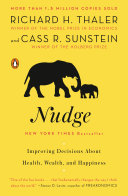

Choice architecture refers to the way in which choices are presented to individuals. The authors, Richard Thaler and Cass Sunstein, argue that the arrangement of options can significantly influence decision-making. By structuring choices in a way that nudges people towards better decisions, we can improve overall outcomes in health, finance, and well-being. For instance, by default enrolling employees into retirement savings plans while allowing them to opt-out, organizations can increase participation rates significantly. The key takeaway is that the design of the environment in which people make decisions can lead to better choices without restricting freedom.
Continue readingLibertarian paternalism is a concept that suggests it is possible to influence people's choices for their own good while still preserving their freedom of choice. Thaler and Sunstein advocate for policies that nudge individuals towards beneficial behaviors without coercing them. This approach respects individual autonomy while also acknowledging that people often make irrational decisions. For example, providing clear information about the benefits of healthier eating can guide individuals towards better dietary choices without forcing them to change their habits.
Continue readingDefaults play a critical role in decision-making, as people tend to stick with pre-set options. This is particularly relevant in contexts such as organ donation or retirement savings. By setting beneficial defaults, such as automatically enrolling employees in a retirement plan, organizations can significantly increase participation rates. The authors illustrate that when individuals are presented with a choice to opt-out rather than opt-in, they are more likely to remain with the default option, leading to improved outcomes in various domains.
Continue readingSocial norms and peer influence can be powerful motivators for behavior change. Thaler and Sunstein emphasize that individuals often look to others when making decisions, which can be harnessed to promote positive behaviors. For instance, informing individuals about the percentage of their peers who engage in energy-saving behaviors can encourage them to adopt similar practices. By leveraging social proof, policymakers and organizations can nudge people towards actions that benefit both individuals and society.
Continue readingFraming effects refer to how the presentation of information can alter perceptions and decisions. The way choices are framed can lead to different outcomes, even when the underlying information remains the same. For example, presenting a medical procedure as having a 90% success rate rather than a 10% failure rate can lead to more positive perceptions and willingness to undergo the procedure. Thaler and Sunstein encourage careful consideration of how information is framed to promote better decision-making.
Continue readingMental accounting is the tendency for individuals to categorize and treat money differently depending on its source or intended use. Thaler and Sunstein discuss how people often compartmentalize their finances, leading to suboptimal decisions. For instance, individuals might treat tax refunds as 'found money' and spend it frivolously rather than saving it. Understanding mental accounting can help individuals and policymakers design strategies that encourage better financial behaviors, such as saving and investing.
Continue readingFeedback is crucial for improving decision-making and behavior change. Thaler and Sunstein highlight that timely and relevant feedback can help individuals understand the consequences of their choices and adjust their behaviors accordingly. For example, providing real-time energy usage data can encourage households to reduce consumption. By implementing systems that offer feedback, organizations can facilitate better decision-making and promote positive behavioral changes.
Continue reading